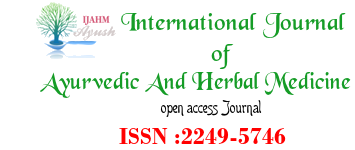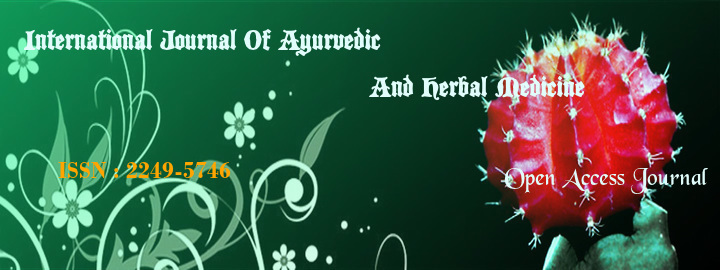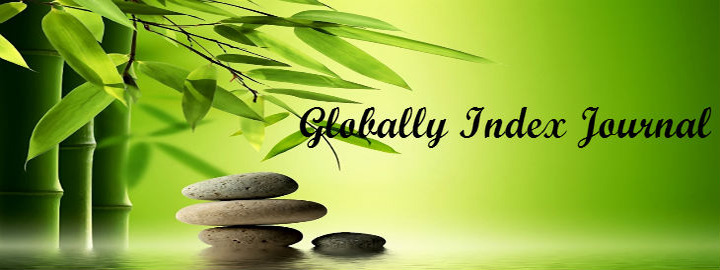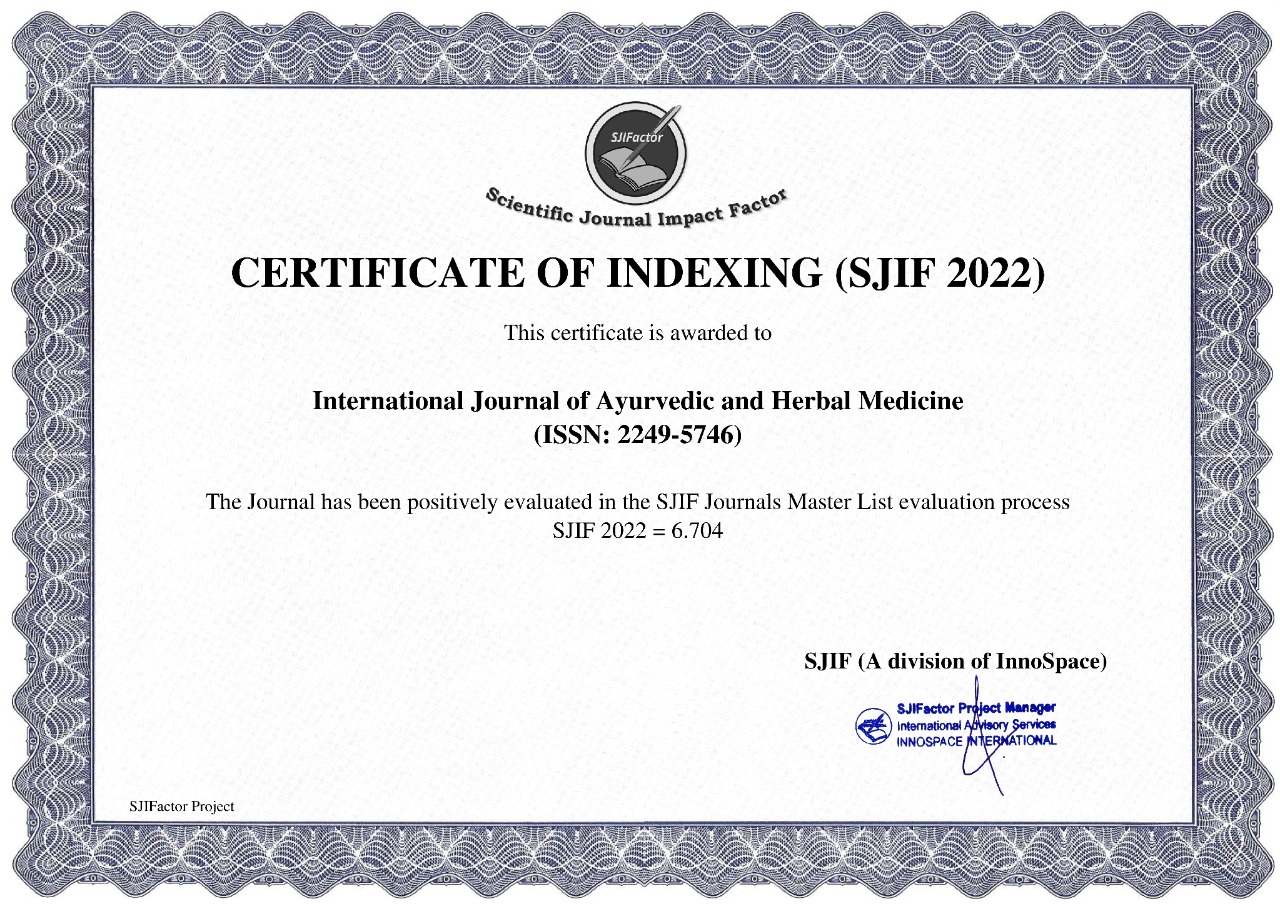


1. Govt. Ayurved College, Osmanabad, Maharashtra, India.
2. Ashtang Ayurved Mahavidyalaya, Pune, Maharashtra, India
E-mail: This email address is being protected from spambots. You need JavaScript enabled to view it.
Abstract
Ageing is a natural ongoing process of unfavourable progressive changes correlated with deterioration in vitality and ending in death. Haritaki (Terminalia chebula Retz.) belonging to the family Combretaceae is the main herb used in Ayurvedic system of medicine since ages. The chapter 4 of Charak Samhita Sutrasthan deals with 50 different groups of 10 herbs with common action. The last of these groups is Vayasthapan Mahakashay i.e. the plants that prevent aging process and maintain the youth. One of the constituents of this group is Abhaya i.e. Haritaki which has an immense therapeutic significance. The plant is also documented to possess beneficial effects such as Rasayana (rejuvenating), Medhya (brain tonic) and Deepan (appetizer). It is very effective in the treatment of various ailments. By the virtues of Agnideepan (stimulating Agni), Aampachan(digesting Aam) and Srotas-shodhana i.e. cleaning the channels by detoxifying the metabolic waste, it supports the nourishment of Dhatus and mind as well as boosts energy. It performs the functions of Dhatwagnideepan in addition to Dhatwagniposhan and helps to improve physical and mental health. It prevents degeneration, extends youth and delays aging or rather reverse the aging process. Following various claims for management of several diseases, efforts have been made by researchers to validate the efficiency of this plant regarding anti-aging potential through scientific biological screening. A analysis of literature in this regard exposed distinguished pharmacological activities of Haritaki like Anti-oxidant, Free radical-scavenging, Cyto-protective, Immuno-modulatory, Anti-mutagenic, Anti-carcinogenic, Radio-protective, Chemo-preventive, Chemo-modulatory, Cardio-protective, Hepato-protective, Nephro-protective, Adaptogenic, Anti-bacterial, Anti-amoebic, Anti-protozoal, Anti-fungal, Anti-viral, Anti-inflammatory and Anti-allergic activity. Its chemical investigation has also shown the presence of important medicinal virtues. The present attempt is to emphasize data about Ayurvedic aspect and phytochemical and relevant pharmacological study for justification of Anti-aging property of Haritaki. The interpretation of phyto-chemical and pharmacological study of this plant confirms the submissions made in the Ayurvedic classics about its Vayasthapan i.e. age sustaing action. The future research on the basis of this compiled information with the use of radiotracers and nuclear imaging techniques to know the action of this marvel drug at the molecular level can pinpoint unexplored potential of it for the treatment of degenerative disorders and give a key for the existing problem of premature aging..
Keywords:
Vayasthapan, Mahakashay, Haritaki, anti-aging
References
1. Ayyanara M, Ignacimuthu S. Ethnobotanical survey of medicinal plants commonly used by Kani tribals in Tirunelveli hills of Western Ghats in India. J Ethnopharmacol. 2011; 134: 851-64
2. Sharma A, Meena S, Barman N. Efficacy of ethyl acetate and ether extract of Terminalia chebula Retz. against some human pathogenic strains. Inter J Pharm Tech Res. 2011; 3: 724-727
3. Prakash DV, Sree Satya N, Sumanjali Avanigadda S, Vangalapati M. Pharmacological review on Terminalia chebula. International Journal of Research in Pharmaceutical and Biomedical Sciences 2012; 3 (2): 679-683
4. Sastri K, Chaturvedi G, editors. Charak Samhita. Chaukhamba Bharti Academy, Varanasi, 1998, 782.
5. Sastri K, editor. Sushruta Samhita. Chaukhamba Sanskrit Sansthana, Varanasi, 2001, 135.
6. Sastri K, Tripathi I, Tripathi S, editors. Ashtang Hridaya. Krishnadas Academy, Varanasi, 1994, 37.
7. Pandey K, Caturvedi GN, editors. Charak samhita of Agnivesh. Vol I, Vimansthan 8/122, Chaukhambha Bharati Academy, Varanasi, 2005, 781-2.
8. Shastri AD, Editor. Sushruta Samhita of Maharsi Sushruta. Part-I, Sutrasthan 35/35-36, Chaukhambha Sanskrit Sansthan, Varanasi, 2005, 134-5.
9. Failla G. The aging process and carcinogenesis. Ann NYAcad Sci. 1958, 74: 1124-35
10. .Free-radical theory of aging. Available from http://en.wikipedia.org/w/index.php?title=Free -radical_theory_of_aging&oldid=617350999
11. Harman D. Free radical theory of aging: Effect of the amount and degree of unsaturation of dietaryfat on mortality rate. J Gerontol 1971; 26(4): 451-7
12. Pacifici RE, Davis KA. Protein, Lipid and DNA Repair Systems in Oxidative Stress, TheFree-Radical Theory of Aging Revisited. Gerontology 1991; 37: 166-80
13. Azizova OA. Role of free radical processes in the development of atherosclerosis. Biol Memb 2002; 9: 451-471
14. Sharma PV,editor. Dalhana and his comment on drugs. Edn1, Manoharlal publishers, New delhi, 1982, 112-13.
15. Mishra R N. Vayasthapak - The Ayurvedic Anti Aging Drugs. International Journal of Research in Pharmaceutical and Biomedical Sciences 2012; 3 (1): 234-249
16. Sharma Ram Karan , Vaidya Bhagwan Dash, editors. Charaka Samhita. Vol- III, Chowkambha Sanskrit Series office, Varanasi, 2008,3.
17. Aneja KR, Joshi R. Evaluation of antimicrobial properties of fruit extracts of Terminalia chebula against dental caries pathogens. Jundishapur J Microbiol 2009; 2(3):105-11
18. Vaidya Yadavaji Trikamji Acharya, editor. Caraka Samhita with Sanskrit Commentary Ayurveda-Dipika by Chakrapanidutta. Sutrasthan 4/18, Chaukhamba Sanskrit Sansthan, Varanasi, 2004, 34
19. Pandey GS, editor. Bhavprakash Nighantu of Shri Bhavmisra with commentary by Dr. Chunekar KC. Haritakyadi varga 7, Edn X, Chaukhambha Bharati Academy, 1995, 3
20. Pulliah T. Encyclopedia of world medicinal plants. Vol IV, Regency Pub, New Delhi, 1931-1934.
21. Chopra RN, Nayar SL, Chopra IC. Glossary of Indian medicinal plants. CSIR, New Delhi, 1956. 242.
22. Bulusu Sitaram, editor. Bhavaprakasa of Bhavamishra, Vol. I, Chaukhamba Orientalia, Varanasi, 2006, 133.
23. CSIR. The Wealth of India, A dictionary of Indian raw material & industrial products, Vol. X, Publication and Information Directorate, New Delhi, 2002, 522-24.
24. Varier, A dictionary of Indian raw materials & Industrial products, Publication and Information Directorate Council of scientific & Industrial research, New Delhi, 2002, 387.
25. Khare C P. Indian medicinal plants: An illustrated dictionary, Springer-verlag, Berlin, 2007 , 652-3.
26. Jagtap AG, Karkera SG. Potential of the aqueous extract of Terminalia chebula as an anticaries agent. Journal of Ethnopharmacology1999; 68(1-3): 299–306
27. Aher V, Wahi AK. Immunomodulatory activity of alcohol extracts of Terminalia chebula Retz Combretaceae. Tropical Journal of Pharmaceutical Research 2011;10(5): 567-575
28. Department of Medical Sciences, Ministry of Public Health. Thai Herbal Pharmacopoeia. Volume II, Nonthaburi, Thailand, 2000, 71-89.
29. Dash B. Materia Medica of Ayurveda. B Jain Publisher, New Delhi, 1991.
30. B Sitaram. Bhavaprakasa of Bhava Misra. Vol. II, Chaukhamba Orientalia, Varanasi, 737.
31. Kumar KJ. Effect of geographical variation on contents of tannic acid, gallic acid, chebulinic acid and ethyl gallate in Terminalia chebula. Natural Products 2006; 2(3-4):170-75
32. Srivastav A et al. Inhibition of hyaluronidase activity of human and rat spermatozoa in vitro and antispermatogenic activity in rats in vivo by Terminalia chebula, a flavonoid rich plant. Reproductive Toxicol 2010; 29:214–24
33. Saleem A, Husheem M, Harkonen P, Pihlaja K. Inhibition of cancer cell growth by crude extract and the phenolics of Terminalia chebula Retz. Fruit. J Ethnopharmacol 2002; 81:327-36
34. Kosta S, Tiwari A. A fusion of ancient medicinal plants with modern conventional therapies on its multifaceted anti diabetic properties. Pharmacol. 2009; 1: 64–77
35. Mokkhasmit M, Swatdimongkol K, Satrawaha P. Study on toxicity of Thai medicinal plants. Bull Dept Med Sci 1971; 12(2/4): 36-65.
36. Worasuttayangkurn L. The study of toxic effects of Terminalia chebula Retz. in mice [dissertation]. Mahidol University, Faculty of Graduation Studies, Thailand, 2001.
37. Panunto W, Jaijoy K, Lerdvuthisopon N, Lertprasertsuke N, Jiruntanat N, Soonthornchareonnon N et al. Acute and chronic toxicity studies of the water extract from dried fruits of Terminalia chebula Rezt. in rats. International Journal of Applied Research in Natural Products 2011; 3 (4):36-43.
38. Cheng HW, Lin TC, Yu KH, Yang CM, Lin CC. Antioxidant and free radical Scavenging activities of Terminalia chebula. Biol Pharm Bull 2003; 26(9): 1331-35
39. Suchalatha S, Srinivasalu C, Devi S. Antioxidant activity of ethanolic extracts of Terminalia chebula fruit against isoproterenol-induced oxidative stress in rats. Indian J Biochem and Biophys 2005; 42: 246- 49
40. Hazra B, Sarkar R, Biswas S, Mandal N. Comparative study of the antioxidant and reactive oxygen species scavenging properties in the extracts of the fruits of Terminalia chebula, Terminalia belerica and Emblica officinalis. BMC Comp Alter Med 2010; 10: 20
41. Walia H. et.al. Analysis of anti-oxidant activity of methanol extract / fraction of T. chebula Ritz. J Chinese clinical medicine 2007; 7(2): 1-12
42. Lee HS, Won NH, Kim KH, Lee H, Jun W, Lee KW. Antioxidant effects of aqueous extract of Terminalia chebula in vivo and in vitro. Biol Pharm Bull 2005; 28(9): 1639-44
43. Lee HS, Jung SH, Yun BS, Lee KW. Isolation of chebulic acid from Terminalia chebula Retz. and its antioxidant effect in isolated rat hepatocytes. Arch Toxicol 2007; 81(3): 211-8.
44. Chen X, Sun F, Ma L, Wang J, Qin H, Du G. In vitro evaluation on the anti-oxidant capacity of triethylchebulate, an aglycone from Terminalia chebula Retz fruit. Indian J Pharmacol 2011; 43(3): 320-23
45. Naik GH, Priyadarsini KI, Naik DB et al. Studies on the aqueous extract of Terminalia chebula as a potent antioxidant and a probable radioprotector. Phytomedicine 2004; 11(6): 530-8
46. Chang CL, Lin CS. Development of antioxidant activity and pattern recognition of Terminalia chebula Retzius extracts and its fermented products. HungKuang J 2010; 61:115–129
47. Mahesh R, Bhuvana S, Begum VM. Effect of Terminalia chebula aqueous extract on oxidative stress and anti-oxidant status in the liver and kidney of young and aged rats. Cell Biochem Funct 2009; 27(6): 358–363
48. Hamada S, Kataoka T, Woo JT, Yamada A, Yoshida T, Nishimura T et al. Immunosuppressive effects of gallic acid and chebulagic acid on CTL-mediated cytotoxicity. Biological & Pharmaceutical Bulletin 1997; 20(9):1017-19
49. Na MK, Bae KH, Kang SS, Min BS, Yoo JK, Kamiryo Y et al. Cytoprotective effect on oxidative stress and inhibitory effect on cellular aging of Terminalia chebula fruit. Phytotherapy Res 2004; 18(9) : 737–41
50. Manosroi A, Jantrawut P, Akihisa T, Manosroi W, Manosroi J. In vitro anti-aging activities of Terminalia chebula gall extract. Pharm Biol 2010; 48(4): 469-81.
51. Chang CL, Lin CS, Lai GH, Chen YH, Tuan WC, Hsu CM. Influence of Terminalia chebula extracts on the effect of PC12 cell growth. J Trad Med 2010; 21(1): 23-30
52. Lee HS, Koo YC, Suh HJ, Kim KY, Lee KW. Preventive effects of chebulic acid isolated from Terminalia chebula on advanced glycation endproduct-induced endothelial cell dysfunction. J Ethnopharmacol 2010; 131(3): 567-574
53. Minkyun NA, Wan BAE, Kang SS, Min BS, Yoo JK, Yuk OK et al. Cytoprotective effect on oxidative stress and inhibitory effect on cellular aging of Terminialia chebula fruit. Phytother Res. 2004; 18: 737–741
54. Aher VD. Immuno-modulatory effect of alcoholic extract of Terminalia chebula ripe fruits. J Pharm Sci Res 2010; 2(9): 539-544
55. Hyun-Sun Lee et al. Preventive effects of chebulic acid isolated from Terminalia chebula on advanced glycation endproduct-induced endothelial cell dysfunction, Journal of Ethnopharmacology 2010;131: 567–574
56. Dwivedi S, Dwivedi A, Kapadia R, Kaul S. Anthelmintic activity of alcoholic and aqueous extract of fruits of Terminalia chebula Retz. Ethnobot Leaflets 2008; 12: 741-743
57. Sohni YR, Bhatt RM. Activity of a crude extract formulation in experimental hepatic amoebiasis and in immunomodulation studies. J Ethnopharmacol 1996; 54(2-3):119-24
58. Arora S, Kaur K, Kaur S. Indian medicinal plants as a reservoir of protective phytochemicals, Teratogenesis, Carcinogenesis, and Mutagenesis 2003; 23(S1): 295-300
59. Reddy DB, Reddy TCM , Jyotsna G, Sharan S, Priya N, Lakshmipathi V et al. Chebulagic acid, a COX–LOX dual inhibitor isolated from the fruits of Terminalia chebula Retz., induces apoptosis in COLO-205 cell line. J Ethnopharmacol 2009; 124(3): 506-12
60. Ponnusankar S, Pandit S, Babu R, Bandyopadhyay A, Mukherjee PK. Cytochrome P450 inhibitory potential of Triphala-A Rasayana from Ayurveda. J Ethnopharmacol 2011; 133(1):120-25
61. Grover IS, Bala S. Antimutagenic activity of Terminalia chebula (myroblan) in Salmonella typhimurium. Indian J Exp Biol 1992; 30(4): 339–341
62. Gandhi NM, Nayar CKK. Radiation protection by Terminalia chebula some mechanistic aspects. Mol Cell Biochem 2005; 277(1–2): 43–48
63. Deepti Dixit et al. Protective effects of Terminalia chebula in modulating oxidative damages against gamma irradiation induced lethality in rats. International Journal of Biological & Pharmaceutical Research 2012; 3(5): 734-742
64. Jagetia GC et al. The evaluation of the radioprotective effect of Triphala (an ayurvedic rejuvenating drug) in the mice exposed to γ-radiation. Phytomedicine 2002; 9: 99-108
65. Prasad L, Husain Khan T, Jahengir T, Sultana S. Chemomodulatory effect of Terminalia chebula against nickel chloride-induced oxidative stress and tumor promotion response in male Wistar rats. J Trace Elem Med Biol 2006; 20(4): 233–239
66. Suchalatha S, Shyamala Devi CS. Protective effect of Terminalia chebula against experimental myocardial injury induced by isoproterenol. Indian J Exp Biol 2004; 42(2): 174-78
67. Suchalatha S, Shyamala Devi CS. Protective effect of Terminalia chebula against lysosomal enzyme alterations in isoproterenolinduced cardiac damage in rats. Exp Clin Cardiol 2005; 10(2): 91-95
68. Suchalatha S, Srinivasan P, Shyamala Devi CS. Effect of T. chebula on mitochondrial alterations in experimental myocardial injury. Chemico-Biological Interactions 2007; 169: 145-53
69. Reddy VRC. Cardioprotective activity of the fruit of Terminalia chebula. Fitoterapia 1990; 61: 517-525
70. Israni DA, Patel KV, Gandhi TR. Anti-hyperlipidemic activity of aqueous extract of Terminalia chebula and Gaumutra in high cholesterol diet fed rats. Int J Pharm Sci 2010; 1(1):48–59
71. Shaila HP, Udupa SL, Udupa AL. Hypolipidemic activity of three indigenous drugs in experimentally induced atherosclerosis. Int J Cardiol 1998; 67(2): 119-24
72. Saravanan S, Shrikumar R, Manikandan S, Jayaparthasarathy N, Sheela Devi R. Hypolipidemic effect of Triphala in experimentally induced hypercholesteremic rats. Yakugaku Zasshi 2007; 127: 2385-388
73. Nair V, Singh S, Gupta YK. Anti-arthritic and disease modifying activity of Terminalia chebula Retz. in experimental models. J Pharm Pharmacol 2010; 62(12): 1801–1806
74. Li K, Diao Y, Zhang H, Wang S, Zhang Z, Yu B et al. Tannin extracts from immature fruits of Terminalia chebula Fructus Retz. promote cutaneous wound healing in rats. BMC Comp Alter Med 2011; 11:1–9
75. Bhattacharya S, Chaudhuri SR, Chattopadhyay S, Bandyopadhyay SK. Healing properties of some Indian medicinal plants against indomethacin-induced gastric ulceration of rats. J Clin Biochem and Nutrition 2007; 41(2):106-14
76. Li K, Diao Y, Zhang H, Wang S, Zhang Z, Yu B et al. Tannin extracts from immature fruits of Terminalia chebula Fructus Retz. promote cutaneous wound healing in rats. BMC Complementary and Alternative Med 2011; 11:8
77. Choudhary GP. Wound healing activity of ethanolic extract of Terminalia chebula Retz. Int J Pharma and Bio Sci 2011; 2(1): 48-52
78. Bagavan A, Rahuman Al, Kamaraj C, Kaushik NK, Mohanakrishnan D, Sahal D. Antiplasmodial activity of botanical extracts against Plasmodium falciparum. Parasitol Res 2011; 108(5):1099–1109
79. Tasduq SA, Singh K, Satti NK, Gupta DK, Suri KA. Terminalia chebula (fruit) prevents liver toxicity caused by sub-chronic administration of rifampicin, isoniazid and pyrazinamide in combination. Hum Exp Toxicol 2006; 25:111-18
80. Rao NK, Nammi S. Antidiabetic and renoprotective effects of the chloroform extract of Terminalia chebula Retz. seeds in streptozotocin-induced diabetic rats. BMC Complementary and Alternative Medicine 2006; 6:17
81. Kannan VR, Rajasekar GS, Rajesh P, Balasubramanian V, Ramesh N, Solomon EK et al. Anti-diabetic activity on ethanolic extracts of fruits of Terminalia chebula Retz. Alloxan- induced diabetic rats. Am J Drug Discov Dev 2012; 2: 135–142
82. Senthilkumar GP, Subramanian SP. Biochemical studies on the effect of Terminalia chebula on the levels of glycoproteins in streptozotocin-induced experimental diabetes in rats. J Appl Biomed 2008; 6: 105-115
83. Kumar GPS, Arulselvan P, Kumar DS, Subramanian SP. Anti-diabetic activity of fruits of Terminalia chebula on streptozotocin-induced diabetic rats. J Health Sci 2006 ;52(3): 283-91
84. Murali YK, Anand P, Tandon V, Singh R, Chandra R, Murthy PS. Long-term effects of Terminalia chebula Retz. on hyperglycemia and associated hyperlipidemia, tissue glycogen content and in vitro release of insulin in streptozotocin-induced diabetic rats. Exp Clin Endocrinol Diabetes 2007; 115(10): 641-46
85. Ramkrishnan Thiruchelvi. Protective effects of T. chebula fruit extracts against cadmium-induced nephrotoxicity in rats. Internations Journal of environmental biology 2012; 2(3): 108-112
86. Rege NN, Thatte UM, Dahanukar SA. Adaptogenic properties of six rasayana herbs used in Ayurvedic medicine. Phytotherapy Res 1999; 13(4): 275-91
87. Khan KH, Jain SK. Regular intake of Terminalia chebula can reduce the risk of getting typhoid fever. Adv Biotech 2009; 8 (9): 10-15
88. Khan KH. The effect of regular intake of Terminalia chebula on oxidative stress in mice originated from Salmonella typhimurium. EurAsia J BioSci 2009; 3: 113-121
89. Malckzadeh F, Ehsanifar H, Shahamat N, Levin M, Colwell RR. Anti-bacterial activity of black myrobalan (Terminalia chebula Retz.) against Helicobactor pyroli. Int J Antimicrob Agent 2001; 85-88.
90. Kannan P, Ramadevi SR, Hopper W. Anti-bacterial activity of Terminalia chebula fruit extract. African J Microbiol Res 2009; 3(4): 180-84
91. Kumar M et al. Anti-microbial activity of aqueous extract of T. chebula. Retz on gram positive and gram negative micro-organisms. Int J Current Pharma Res 2009; 1(1): 56-60
92. Sharma A et al. Efficacy of ethyl acetate & ether extract of T. chebula Retz. against some human pathogenic strengths. Int J Pharmtec Res 2011; 3(2): 724-27
93. Dolly Singh et al. Therapeutical effect of extracts of T. chebula in inhibiting human pathogens and free radical. Int J Bioscience, Biochemistry and Bioinformatics 2012; 2: 3
94. Ahmad I, Mehmood Z, Mohammad F. Screening of some Indian medicinal plants for their antimicrobial properties. J Ethnopharmacol 1998; 62: 183-93
95. Shaiderraza Naqvi. Evaluatuin of antimicrobial properties of T. chebula Retz, Pakistan journal of Pharmacology 2010; 27(1): 29-35
96. Sato Y, Oketani H, Singyouchi K, Ohtsubo T, Kihara M, Shibata H et al. Extraction and purification of effective anti-microbial constituents of Terminalia chebula Retz. against methicillin-resistant Staphylococcus aureus. Bio Pharm Bull 1997; 20 (4): 401-04
97. Kim HG, Cho JH, Jeong EY, Lim JH, Lee SH, Lee HS. Growth-inhibiting activity of active component isolated from Terminalia chebula fruits against intestinal bacteria. J Food Prot 2006; 69(9): 2205-9
98. Sohni YR, Kaimal P, Bhatt RM. The anti-amoebic effect of a crude drug formulation of herbal extracts against Entamoeba histolytica in vitro and in vivo. J Ethnopharmacol 1995; 45(1): 43-52
99. Bagavan A, Rahuman Al, Kamaraj C, Kaushik NK, Mohanakrishnan D, Sahal D. Anti-plasmodial activity of botanical extracts against Plasmodium falciparum. Parasitol Res 2011; 108(5): 1099-1109
100. Barazani VO, Sathiyomoorthy P, Shalev R, Vardy D, Golan GA. Screening of South-Indian medicinal plants for anti-fungal activity. Phyther Res 2003; 17(9): 1123-1125
101. Dutta BK, Rahman I, Das TK. Anti-fungal activity of Indian plant extracts. Mycoses 1998; 41(11-12): 535-536
102. Mehmood Z, Ahmad I, Mohammad F, Ahmad S. Indian medicinal plants: A potential source for anti-candidal drugs. Pharmaceutical Biology 1999; 37(3): 237–42
103. Vonshak O, Barazani P, Sathiyomoorthy R, Shalev D, Vardy A Golan-goldhirsh. Screening of South-Indian medicinal plants for anti-fungal activity. Phytotherapy Res 2003; 17(9): 1123-25
104. Yukawa TA, Kurokawa M, Sato H, Yoshida Y, Kageyama S, Hasegawa T et al. Prophylactic treatment of cytomegalovirus infection with traditional herbs. Antiviral Res 1996; 32(2): 63-70
105. Badmaev V, Nowakowski M. Protection of epithelial cells against influenza A virus by a plant derived biological response modifier Ledretan-96. Phytotherapy Res 2000; 14(4): 245-49
106. Vermani K, Garg S. Herbal medicines for sexually transmitted diseases and AIDS. J Ethnopharmacol 2002; 80(1): 49-66
107. Mekkaway SE, Meselhy MR, Kusumoto IT, Kadota S, Hattori M, Namba T. Inhibitory Effects of Egyptian Folk Medicines oh Human Immunodeficiency Virus (HIV) Reverse Transcriptase. Chemical and Pharmaceutical Bulletin 1995; 43(4): 641-48
108. Ahn MJ, Kim CY, Lee JS, Kim TG, Kim SH, Lee CK et al. Inhibition of HIV-1 integrase by galloyl glucoses from Terminalia chebula and flavonol glycoside gallates from Euphorbia pekinensis. Planta Med 2002; 68(5): 457-59
109. Hong-Xi-Xu et.al. Screening of traditional medicine for their inhibitory activity against HIV-1 protease, Phytotherapy Research, 1996; 10: 207-10
110. Tae Gyun Kim et al. Antiviral activity of extracts isolated from T. chebula Ritz. Sanguisorba officinalis L., Rubus corenus miq. and Rheum palmatum L. against Hepatitis B virus. Phototherapy research 15(8): 718-20
111. Lin LT, Chen TY, Chung CY, Noyce RS, Grindley TB, McCormick C et al. Hydrolyzable tannins (chebulagic acid and punicalagin) target viral glycoprotein glycosaminoglycan interactions to inhibit herpes simplex virus 1 entry and cell-to-cell spread. J Virol 2011; 85(9): 4386-98
112. Masahiko Kurokawa et al. Efficacy of traditional herbal medicines in combination with Acyclovir against herpes simplex virus type-1 infection in vitro and in vivo, Antiviral Research1995; 27: 19-37
113. Ma H, Diao Y, Zhao D, Li K, Kang T. A new alternative to treat swine influenza A virus infection: extracts from Terminalia chebula Retz. African J Microbiol 2010; 4 (6): 497-99
114. Moeslinger T, Friedl R, Volf I, Brunner M, Koller E, Spieckermann PG. Inhibition of inducible nitric oxide synthesis by the herbal preparation Padma 28 in macrophage cell line. Can J Physiol Pharmacol 2000; 78(11): 861-866
115. Pratibha N, Saxena VS, Amit A, D’Souza P, Bagchi M, Bagchi D. Anti-inflammatory activities of Aller-7, A novel polyherbal formulation for allergic rhinitis. Int J Tissue React 2004; 26(1-2): 43-51
116. Mokkhasmit M et al. Pharmacological evaluation of Thai medicinal plant. Journal of the Medical Association of Thailand 1971; 54: 490-504
117. Aeom YD et al. Anaphylactic reaction inhibitory effect of F. chebula. Korean Journal of Herbology 2000; 15: 123-128
118. Shin TY et al. Inhibitory action of water soluble fraction of Terminalia chebula on systemic and local anaphylaxis. Journal of Ethnopharmacology 2001; 74: 133–140
119. Singh, R.H. Contemporary strength of Ayurvedic geriatrics. National Workshop proceedings on Ayurveda and Siddha for geriatric health care. Cetral Council for Research in Ayurveda and Siddha, Department of AYUSH, New Delhi, India, 2008
120. Sharma PV, Introduction to Dravyaguna, Chaukhambha Orientalia, Varanasi ,2010, 49
121. Yadavaji Trikamji Acharya, editor. Caraka Samhita with Sanskrit Commentary Ayurveda-Dipika by Chakrapanidutta. Chikitsasthan-1/1-8, Chaukhamba Surabharti Prakshan, Varanasi, 2005, 376.
122. Tripathi Brahmananda, editor. Sharangdhar Samhita with Dipika Hindi commentary, Poorvakhand 4/13 Choukhambha Surbharati Prakashan, Varanasi, 2006, 48
123. Shastri Kaviraj Ambika Dutta, Rajeshwar Dutta Shastri. Bhaishjya Ratnawali with Hindi commentary, Rasayanprakaran 73/1, Choukhambha Prakashan Varanasi, 2012, 1102
124. Anwesa Bag et al. Therapeutic potential of Terminalia chebula Retz. (Combretaceae): The Ayurvedic Wonder. Asian Pac J Trop Biomed 2013; 3(3): 244-252
125. M.R. Alberto, C. Gómez-Cordovés, M. C. Manca De Nadra. Metabolism of gallic acid and catechin by Lactobacillus hilgardii from wine. Journal Agriculture and Food Chemistry 2004; 52: 6465-6469
126. Shoji T, Mutsuga M, Nakamura T, Kanda T, Akiyama H, Goda Y. Isolation and structural elucidation of some procyanidins from apple by low- temperature NMR. Journal of Agricultural and Food Chemistry 2003; 5: 3806-3813
127. Graf BA, Milbury PE, Blumberg JB. Flavonols, flavones, flavanones, and human health: Epidemiological evidence. Journal of Medicinal Food 2005; 8: 281-290
128. Ross JA, Kasum CM. Dietary flavonoids: Bioavailability, metabolic effects, and safety. Annual Reviews of Nutrition 2002; 22: 19-34
129. Soobrattee MA, Bahorun T, Aruoma OI. Chemopreventive actions of polyphenolic compounds in cancer. Biofactors 2006; 27: 19-35
130. Ramos S. Cancer chemoprevention and chemotherapy: Dietary polyphenols andsignaling pathways. Molecular Nutritionand Food Research 2008; 52: 507-526
131. Chung KT, Wong T Y, Wei CI, Huang YW, Lin Y. Tannins and humanhealth: a review. Critical Reviews in Food Science and Nutrition, 1998; 38 : 421-464
132. Okuda T. Tannins, a new family of bio-active natural organic compounds questions and answers. Yakugaku Zasshi 1995; 115: 81-100
133. Noroozi M, Angerson WJ, Lean MEJ. Effects of flavonoids and vitamin C on oxidative DNA damage to human lymphocytes. American Journal of Clinical Nutrition 1998; 67: 1210-1218
134. Bravo L. Polyphenols: chemistry, dietary sources, metabolism and nutritional significance. Nutrition Research Review 1998; 56: 317- 333
135. Lairon D, Amiot MJ. Flavonoids in food and natural antioxidants in wine. Current Opinion Lipidology 1999; 10: 23-28
136. Appel LJ, Moore TJ, Obarzanek E. A clinical trial of the effects of dietary patterns on blood pressure. The New England Journal of Medicine 1997; 336: 1117-1124
Williams RJ, Spencer JPE, Rice-Evans C. Flavonoids: Anti-oxidants or signalling molecules? Free Radical Biology and Medicine 2004; 36: 838-849
index























